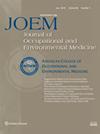世贸中心相关下呼吸道疾病的聚类分析。
IF 1.4
4区 医学
Q2 PUBLIC, ENVIRONMENTAL & OCCUPATIONAL HEALTH
Journal of Occupational and Environmental Medicine
Pub Date : 2023-11-29
DOI:10.1097/jom.0000000000003023
引用次数: 0
摘要
简介聚类分析可以在没有先验假设的情况下对世贸中心(WTC)灾难现场前工作人员中发现的异质性慢性下呼吸道疾病进行分类。方法:我们选取了第一份可获得的胸部计算机断层扫描图像,并对 311 名前世贸中心工人进行了定量计算机断层扫描测量,这些工人在最近的监测访问中提供了完整的临床和肺活量数据。我们使用差距测量法进行了非层次迭代算法 K 原型聚类分析。结果显示五个聚类的解决方案最令人满意。第 5 组的人最健康。在第 4 组中,吸烟最为普遍和严重,但很少有呼吸系统疾病的证据。第 3 组的受试者有症状,用力呼吸量减少(FVC 低)。第 1 组和第 2 组有较少呼吸困难的受试者,但第 1 组有较多慢性阻塞性肺病(COPD)的功能性和定量计算机断层扫描证据,第 2 组有较低的 FVC。第 1 组和第 4 组第一秒用力呼气量快速下降者的比例最高。结论:聚类分析证实,在对 WTC 工人的长期监测中,低 FVC 和慢性阻塞性肺病/慢性阻塞性肺病前期是独特的慢性下气道疾病表型。本文章由计算机程序翻译,如有差异,请以英文原文为准。
Cluster Analysis of World Trade Center Related Lower Airway Diseases.
Introduction: Cluster analysis can classify without a priori assumptions the heterogeneous chronic lower airway diseases found in former workers at the World Trade Center (WTC) disaster site. Methods: We selected the first available chest computed tomography scan with quantitative computed tomography measurements on 311 former WTC workers with complete clinical, and spirometric data from their closest surveillance visit. We performed a nonhierarchical iterative algorithm K-prototype cluster analysis, using gap measure. Results: A five-cluster solution was most satisfactory. Cluster 5 had the healthiest individuals. In cluster 4, smoking was most prevalent and intense but there was scant evidence of respiratory disease. Cluster 3 had symptomatic subjects with reduced forced vital capacity impairment (low FVC). Clusters 1 and 2 had less dyspneic subjects, but more functional and quantitative computed tomography evidence of chronic obstructive pulmonary disease (COPD) in cluster 1, or low FVC in cluster 2. Clusters 1 and 4 had the highest proportion of rapid first-second forced expiratory volume decliners. Conclusions: Cluster analysis confirms low FVC and COPD/pre-COPD as distinctive chronic lower airway disease phenotypes on long-term surveillance of the WTC workers.
求助全文
通过发布文献求助,成功后即可免费获取论文全文。
去求助
来源期刊

Journal of Occupational and Environmental Medicine
医学-公共卫生、环境卫生与职业卫生
CiteScore
4.20
自引率
9.40%
发文量
402
审稿时长
3-8 weeks
期刊介绍:
Journal of Occupational and Environmental Medicine is an indispensable guide to good health in the workplace for physicians, nurses, and researchers alike. In-depth, clinically oriented research articles and technical reports keep occupational and environmental medicine specialists up-to-date on new medical developments in the prevention, diagnosis, and rehabilitation of environmentally induced conditions and work-related injuries and illnesses.
 求助内容:
求助内容: 应助结果提醒方式:
应助结果提醒方式:


